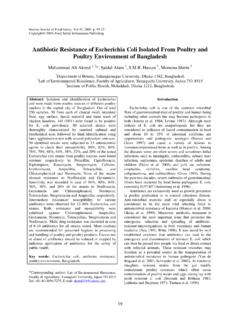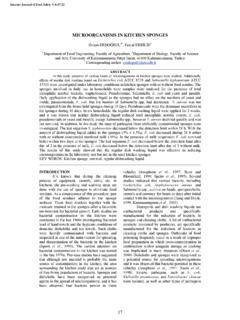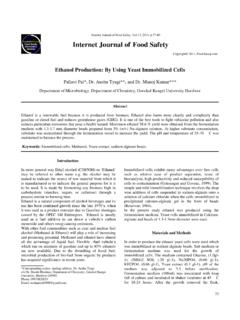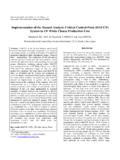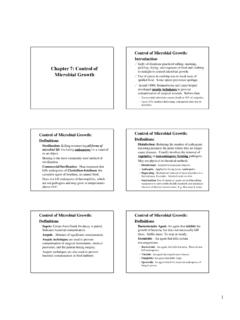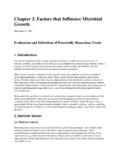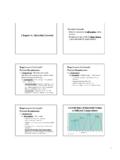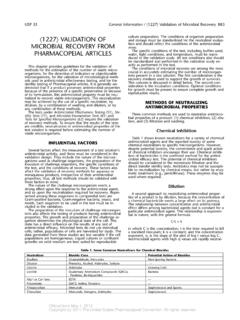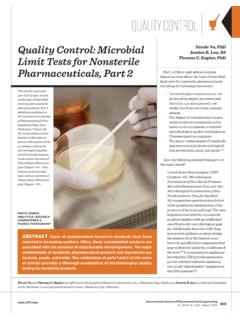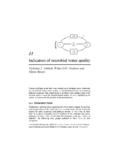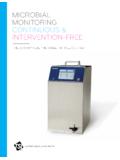Transcription of Microbial Safety of Fruit and Vegetable products …
1 Internet Journal of Food Safety , Vol. 4, 2004, p. 21-32. Copyright 2004, Food Safety Information Publishing Microbial Safety of Pickled Fruits and Vegetables and Hurdle Technology Sun-Young Lee*. Department of Food Science and Human Nutrition, Washington State University, Pullman, Washington 99164-6376. Escherichia coli O157:H7 is a member of the enterohemorrhagic group of pathogenic E. coli that has emerged as a foodborne pathogen of major public health concern. E. coli O157:H7 is highly tolerant of acidic pH and outbreaks attributed to this bacterium have been in many acidic foods which have pH level with similar to those of pickled products . Therefore, pickled vegetables, although acidic, may not safe. In pickling vegetables, the combination of preservation factors (heat, acetic acid, and salt) will contribute to increase the Microbial Safety .
2 Recently, the concept of combining preservative factors for food preservation was developed, called hurdle technology'. In hurdle technology, combination treatments are applied because it is expected that the use of combined preservative factors will have greater effectiveness at inactivating microorganisms than the use of any single factor. However, recent studies show that the combination of preservation factors can have unexpected antimicrobial activity. Therefore, this article includes an overall review of the Microbial Safety of fruits and vegetables, preservative method including major preservative factors used in pickling technology, concept and mechanism of hurdle technology and E. coli O157:H7. 1. Microbial hazards in fruits and vegetables Although the incidence of foodborne illnesses linked to The quality of food can be adversely affected by physical, fresh produce is low, there is increased awareness that fruits chemical, biochemical and microbiological processes.
3 And vegetables can be contaminated with microbiological Quality deterioration caused by microorganisms may pathogens. For its microbiological sampling program of include a wide range of types of spoilage that are certain fresh fruits and vegetables, the Food and Drug undesirable commercially, because they limit shelf life or Administration (FDA) conducted surveys of both imported lead to quality complaints, but are safe from a public health and domestic produce. A 4% (44 of 1003 sampled). point of view. More seriously, the presence or growth of contamination rate was reported in published results for infectious or toxinogenic microorganisms (foodborne imported products (Novak et al., 2003). In the interim report pathogens) represent the worst forms of quality deterioration, on domestic products , there was a contamination rate because they threaten the health of the consumer (ICMSF, (Novak et al.))
4 , 2003). With the shift in diet toward the 1996). Therefore, while the aim of effective food consumption of more fresh fruits and vegetables and greater preservation is to control all forms of quality deterioration, distribution distances from new geographic sources, there the overriding priority is always to minimize the potential have been more reported illnesses involving fresh produce for the occurrence and growth of food spoilage and food (Tauxe, 1997). In the United States from 1988 to 1992, 64. poisoning microorganisms (ICMSF, 1996). outbreaks of disease were related to the consumption of Despite the extensive scientific progress and fruits and vegetables resulting in 9 deaths (Bean et al., 1996). technological developments achieved in recent years, food From 1993 to 1997, in 66 outbreaks with 2 deaths, fruits and Safety problems continue to exist and may actually increase vegetables were the vehicles of transmission (Sumner and in the future.
5 It is estimated that foodborne pathogens cause Peters, 1997). Because foodborne infections are sporadic approximately 76 million illnesses, 325,000 hospitalizations, and many go unreported, the exact numbers of cases related and 5,000 deaths in the United States each year, most due to to produce is unknown (Tauxe, 1997). Due to changes in the unknown causative agents (Mead et al., 1999). Among the food supply and food consumption patterns in the United know pathogens associated with foodborne illnesses, there States, deaths caused by foodborne diseases are even more is an increasing involvement of environmentally resistant difficult to estimate (Mead et al., 1999). These foodborne and host-adapted species or strains, which may be difficult outbreaks cause gastroenteritis and in severe cases, to inactivate or control with traditional food preservation hospitalization is required.
6 Fruit and Vegetable methods (Alterkruse et al., 1997; Foster, 1997; Tauxe, 1997) contamination problems can occur in the growing environment. During growth the Fruit or Vegetable can become contaminated from sources such as soil, water, *Corresponding author, mailing address: Department of Food animals, birds, and insects. Following production, the Science and Human Nutrition, Washington State University, processes of harvesting, washing, cutting, slicing, packaging, Pullman, WA 99164-6376. Phone: 509-335-7608, Fax: 509-335- and shipping can create additional conditions where 4815. E-mail: contamination can occur. Because of high water activity 21. S. Y. LEE AND D. H. KANG. TABLE 1. Most important hurdles for food preservation Hurdles used for food preservation influence the quality (adapted from Leistner, 1995) as well as the Safety of foods.
7 The effects of hurdles on food quality can be positive or negative, depending on their Symbol Parameter Application intensity. Some hurdles ( Maillard reaction products ). F High temperature Heating have antimicrobial properties and at the same time improve T Low temperature Chilling, freezing the flavor of the products ; this also applies to nitrite used in Reduced water the curing of meat. However, some hurdles also provide a aw Drying, curing, conserving activity negative effect on food quality. For instance, chilling to an pH Increased acidity Acid addition or formation unsuitably low temperature will be detrimental to some Reduced redox Removal of oxygen or foods of plant origin ( chilling injury'), whereas moderate Eh chilling is beneficial for shelf-life.
8 Another example is the potential addition of ascorbate Pres. Preservatives Sorbate, sulfite, nitrite, pH of fermented sausages, which should be low enough to inhibit pathogenic bacteria but now so low as to impair taste. Competitive flora Microbial fermentations If the level of a particular hurdle in a food is too small, it should be strengthened; if it is detrimental to the food (aw) and nutrient content, fresh produce can support the quality, it should be lowered and an additional hurdle growth of a variety of disease-causing microorganisms considered. (Sumner and Peters, 1997). Pathogens frequently associated To ensure the stability and Safety of foods, each hurdle with minimally processed vegetables include Escherichia should be applied in the proper manner.
9 However, the high coli O157:H7, Listeria monocytogenes, Clostridium strength or concentration of any single hurdle could botulinum, Aeromonas hydrophila, Salmonella spp., and adversely affect food quality such as loss of nutrients, Campylobacter jejuni (Schuenzel and Harrison, 2002). texture, color, etc. Therefore, if manufacturers are to achieve a product that accommodates consumer preferences 2. Food preservation technology while remaining safe and stable, they must achieve Food preservation in the broad sense of the term refers to synergies through the combined use of these or other all measures taken against any spoilage of food. In its hurdles which, while they may not prevent the growth of narrower sense, however, food preservation connotes pathogenic or spoilage microorganisms on their own, will processes directed against food spoilage due to Microbial or do so collectively.
10 And each product may require a different biochemical action. Preservation technologies are based combination of hurdles, depending on a range of factors mainly on the inactivation of microorganisms or on the including the following; (i) the initial Microbial load of the delay or prevention of Microbial growth. Consequently they product requiring preservation, (ii) how favorable conditions must operate through those factors that most effectively are within the product for Microbial growth, (iii) target influence the survival and growth of microorganisms shelf-life. (ICMSF, 1980). An important current trend is toward the use of Factors used for food preservation are called hurdles' procedures that deliver food products are less heavily.

